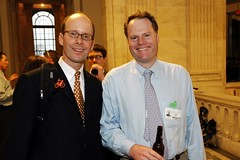A few weeks ago, I reported on a presentation that Trek Bicycles President John Burke gave at the National Bike Summit.

and tireless bicycle advocate Jay Graves.
File photo from National Bike Summit, 3/15/07
It was a preview of a presentation he gave just a few days ago at the Taipei Cycle Show. Borrowing in style and tone from Al Gore in his heralded Inconvenient Truth slideshow, Burke waves a warning flag to America’s bicycle industry.
He says that global trends in obesity, urbanization, pollution, and congestion pose major challenges that can be solved by the industry if more action and resources are directed to bicycle advocacy instead of product development and marketing.
To illustrate examples of places where advocacy has succeeded, Burke mentions Portland:
“The industry’s greatest opportunity is to create a bicycle-friendly world… and to me, the best thing about that is that we don’t have to re-invent the wheel. A bicycle-friendly world already exists in a number of places. It already exists in the Netherlands, Boulder, London, and it exists in Portland Oregon.”
Burke sent me a copy of his presentation (download the PDF). One of the slides demonstrates the immense growth in size of the bicycle industry if bicycle trips in America went from their current level of less than 1% to just 5% of all trips.

The graphic below shows the glaring disparity between marketing/R&D and advocacy budgets in the bike industry:

According to Burke, there are four key steps all members of the bike industry should take:
-
1) Get involved with government leaders.
2) Get involved with advocates.
3) Take responsibility for your major/home markets.
4) Re-direct resources away from traditional spending to advocacy.
Burke’s talk — in which he admits even Trek could do more — has re-ignited a very important conversation in the bicycle industry. Many insiders have long criticized the industry for being too wrapped up in itself, focusing on the latest carbon widget or lightweight part instead of making sure there were safe and accessible places to use them.
One industry veteran (who wants to remain anonymous) put it to me this way,
“We don’t need improved graphics, new carbon link arms, and more forgettable ads in Outside magazine. Just look in the garages of the people in your neighborhood. A new gadget won’t help them if they don’t know how to get from home to work safely, or if they lack a shower and locker facility at work. A product specific approach will not get more people on bikes. Advocacy groups don’t need a tag line, they need dough and the support of corporate leadership. I don’t want to be sour grapes, but I disagree with the immediacy of return and brand specificity of the industry’s marketing approaches as of late.”
The ball is in the industry’s court. They cannot just sit back and count their money, while understaffed and underfunded advocates and advocacy groups struggle to do the heavy lifting that sells their products.
===============
Further info
- British cycling journalist juggernaut (and editor of BikeBiz) Carlton Reid was in Taipei and put together a video of Burke making this presentation.
- You can also download the slideshow in PDF format (2.0MB) or watch it on YouTube (thanks again to Carlton Reid).
- Read an article about Burke in Taipei from BikeBiz.

